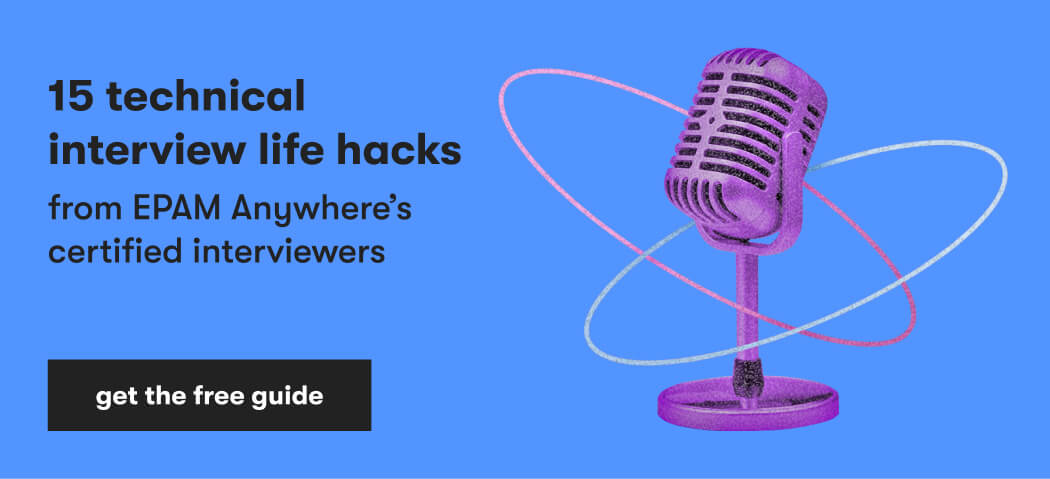Amazon Web Services (AWS) is a dominant force in the cloud landscape, snagging 33% of market share as of Q1 2022, according to Synergy Research Group. Saying that demand for AWS cloud developers is on the rise is a massive understatement.
While that’s good news for anyone looking for AWS developer remote jobs, that doesn’t mean your job search is guaranteed smooth sailing. AWS cloud interview questions are often highly complex, particularly at companies where training a candidate to handle the nuances of the role isn’t an option.
For any AWS professional looking to shine during a job interview, it’s essential to ensure that you’re ready for what lies ahead. Fortunately, that journey is far simpler if you spend a little time reviewing AWS developer interview questions in advance.
want to work remotely...
and wondering where to find the best opportunities? Simply send us your CV, and our skilled recruiters will identify best-matching roles that align with your skills and help you excel.
10 AWS basic interview questions and answers
Some AWS interview questions are relatively universal. Odds are you’ll encounter them regardless of whether you’re focused on an entry-level opportunity or a role that requires ample experience. Since that’s the case, it’s wise to spend some time and energy learning the basic AWS interview question and answers to review:
1. What are the AWS components?
Below are the AWS components:
- Data Management and Data Transfer
- Compute and Networking
- Storage
- Automation and Orchestration
- Operations and Management
- Visualization
- Security and Compliance
This question often comes up early in an interview, particularly for entry-level roles. It’s a basic knowledge test, allowing you to show that you understand the fundamentals. In most cases, a simple list-based answer is sufficient, as that keeps your answer concise.
2. Which load balancer supports path-based routing?
The application load balancer supports path-based routing.
Like the question above, this is designed to test your general knowledge of AWS and cloud computing. Usually, you don’t have to provide any information beyond what’s shown above, as you’re essentially showing that you understand a critical fact.
3. What is the availability zone and region in AWS?
A region represents a separate geographic area in AWS, and availability zones are highly available data centers within each AWS region. Also, each region has multiple isolated locations known as availability zones. The code for the availability zone is its region code followed by a letter identifier. The best example is us-east-1a.
Providing the example at the end lets you add that little something extra to your response without going too far. It’s a way to highlight your expertise when you’re answering AWS cloud engineer interview questions a little bit more, which can make a difference.
4. Why is VPC needed?
VPC — or Virtual Private Cloud — is used to create a virtual network in the AWS cloud. It provides complete control over a virtual networking environment, including resource placement, connectivity, and security.
The answer above is pretty concise, but it covers most of the important points. However, if you want to take your answer to this and similar AWS engineer interview questions up a notch, consider following it up with an example from your past experience. For instance, mention a time you utilized VPC in a project and the benefits you gained from doing so.
5. What types of instances do you know?
Below are the different types of AWS instances:
- General Purpose
- Compute Optimized
- Memory Optimized
- Accelerated Computing
- Storage Optimized
The trick with AWS data engineer interview questions such as these is the phrasing. Since the hiring manager is asking about the ones you “know,” you may want to start with the instances you’re most experienced with. Then, you can also mention ones that you’re familiar with, at least in a general sense.
6. What is auto-scaling?
Auto-scaling monitors your applications and automatically adjusts capacity to maintain a steady, predictable performance at the lowest possible cost. It makes scaling simple with recommendations that allow you to optimize performance, cost, or balance between them.
Here’s another opportunity to mention an example from your past experience. If you successfully used auto-scaling to balance cost and performance, discuss that project after you provide the definition to highlight not just your knowledge but your ability to apply it effectively.
7. What restrictions apply to AWS Lambda function code?
AWS Lambda has the following restrictions:
- Maximum disk space — 512 MB
- Default deployment package size — 50 MB
- Memory range — 128 to 3008 MB
- A function's maximum execution timeout is 15 minutes
In most cases, simply listing the restrictions is enough to answer this question well. However, you can also mention why the restrictions are in place if you want to add something extra to your response.
8. How do you trace user requests to Rest APIs (API Gateway)?
We can use AWS X-Ray to trace and analyze user requests as they travel through your Amazon API Gateway REST APIs to the underlying services.
Again, this is a question where you can follow up your basic answer with an example. That can make your response more impressive.
9. What’s the difference between Amazon S3 and EC2?
The main difference between Amazon S3 and EC2 is that S3 stores large amounts of data while EC2 runs the servers in the cloud.
Along with mentioning that point, consider relaying examples of times when you used each technology.
10. Explain how elasticity differs from scalability.
Elasticity enables you to meet dynamic changes, while scalability provides the static increase in the workload. The main purpose of elasticity is to match the resources allocated with the actual amount of resources needed at any given point in time. Scalability handles the changing needs of an application within the boundary of the infrastructure via statically adding or removing resources to meet the application's demands if needed.
The answer above is usually enough. However, time permitting, you can include examples from your work history to drive the points home.
10 AWS interview questions and answers for experienced engineers
As you advance in the field, the interview process gets increasingly challenging. Hiring managers have more expectations regarding your knowledge of big data, database management, system operations, and more. You’re more likely to engage with complex AWS technical interview questions than basic ones like those outlined in the section above.
Fortunately, you can still prepare by reviewing AWS cloud engineer interview questions and answers. They will give you a working foundation, ensuring you’re ready for the types of questions the hiring manager will likely ask.
Here are the top 10 AWS interview questions and answers for experienced engineers:
1. What are the methods to deploy the latest application package to the servers in the autoscaling group in AWS?
There are three deployment methods which are as follows:
- Using Codepipeline — Deploy the code when the server gets created.
- Replacing image — Deploy the code to a temporary server, take the image, and replace the image in the autoscaling group.
- Changing the start-up script/user data in the autoscaling launch config — Pull the code and restart the application server whenever a new server is created.
If you have time, consider providing examples of when you’ve used the various deployment methods. Even if you just briefly mention them, it lets the hiring manager know you’re experienced. Plus, they can always ask follow-up questions for more details.
2. Do we need to open outbound port 80/443 on the load balancer's security group to allow return traffic from the server?
No, the outbound port is not required to be kept open.
You can leave your answer that simple if you like. However, you may want to expand on your answer and explain why that’s the case if you have the opportunity.
3. How do you encrypt the connection in transit to RDS?
You use the certificate bundle (TLS/SSL) created by RDS to encrypt the connection in transit.
In most cases, a straightforward answer is fine here, but you do have the option to expand. First, you could reference an example of a time when you tackled that task. Second, you can talk about how the certificate bundle encrypts the connection. The former highlights experience, while the second showcases knowledge, so use the approach that makes the most sense for your situation.
4. How do you enhance AWS security with best practices?
AWS security best practices are as follows:
- Use accurate account information
- Use MFA (multi-factor authentication)
- Validate IAM roles
- Rotate your keys
- Limit security groups
Mention the best practices as a starting point. Then, discuss how they impact security, using examples of the types of activity they are meant to promote or prevent.
5. What are the advantages of Redshift in AWS?
The advantages of Redshift in AWS include:
- Wide adoption
- Ease of administration
- Ideal for data lakes
- Ease of querying
- Columnar storage
- Performance
- Scalability
- Security
- Strong AWS ecosystem
- Pricing
With this answer, you may want to steer away from a simple list. Instead, list some advantages and explain why they’re beneficial based on your experience. Then, present the remaining ones as a list, expanding on the last point you share to make the end of your response more compelling.
6. What are the differences between a core node and task node in EMR?
A core node contains software components that run tasks and store data in a Hadoop Distributed File System, or HDFS. Multi-node clusters have at least one core node. A task node contains software components that only run tasks. Also, it does not store data in HDFS and is technically optional.
If you have an example from your work history that you can use to demonstrate the difference, then consider doing so. Otherwise, a fact-based response is sufficient.
7. How can you speed up data transfer in Amazon Snowball?
There are several ways to speed up data transfer in Amazon Snowball, including:
- Use the latest Mac or Linux Snowball client
- Batch small files together
- Perform multiple copy operations at one time
- Copy from multiple workstations
- Transfer directories but not files
- Don't perform other operations on files during transfer
- Reduce local network use
- Eliminate unnecessary hops
Here’s another one of the AWS interview questions for cloud developers where integrating some examples into your list can make for a stronger answer. Reference a past project or workplace task you handled to outline the difference a few of the techniques above make.
8. How do you upload a file larger than 100 MB in Amazon S3?
There are two main options for uploading a file larger than 100 MB in Amazon S3: use the AWS Command Line Interface or use the AWS SDK.
If you want to make your answer more impactful, you can outline situations where one option may be better than another. Alternatively, you can discuss your past experience using the approaches.
9. Describe AWS routing policies.
Below are the AWS routing policies:
- Simple routing policy
- Failover routing policy
- Geolocation routing policy
- Geo-Proximity routing (traffic flow only) policy
- Latency-based routing policy
- IP-based routing policy
- Multi-value answer routing policy
- Weighted routing policy
With AWS cloud interview questions like this, you typically need to expand a little on each point. Since there are so many policies, just briefly explain each policy’s general purpose in one sentence. Otherwise, your response could end up being too long.
10. What are the consistency models in DynamoDB?
The consistency models in DynamoDB are as follows:
- Eventual consistency model — maximizes the read throughput with low latency
- Strong consistency model — provides updated data with high latency
You may want to touch on the benefits and drawbacks of each option or outline use cases for them based on your past experience to make your response more well-rounded.
Apply for remote AWS jobs at EPAM Anywhere
With so many opportunities for AWS cloud developers, now is the perfect time to search for your dream job. If you’re ready to advance your career, check out our open remote AWS jobs and apply today.

Explore our Editorial Policy to learn more about our standards for content creation.
read more





























